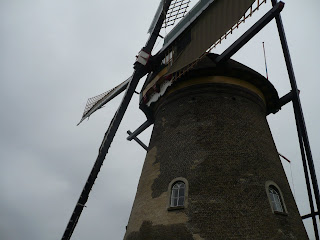Thursday, April 28, 2011
KINDERDIJK: WINDMILLS AND QUIXOTES
In Holland one major attraction is the row of windmills in Kinderdijk that still stands ready to pump water out of the fields and back into the river above. These structures are, when you are standing there looking at them, much larger than the imagination as guided by Cervantes. I was struck by their absolute gigantism. What occurred to me immediately is the question: “What was Don Quixote thinking when he dared to attack such a monster?”
First, let me mention that the Dutch government demands that all these old windmills be kept active and operated at regular intervals. The point is that they work and they do not need electricity or any other source of power except for the wind, which keeps coming intensely from the water. There are many other modern white windmills along the coast – indeed, an astonishing armada of windmills that must power many more things than the pumps that keep the waters at bay. It is a tribute to the Dutch willingness to tolerate despoiling the landscape for the sake of maintaining the overall ecology of their part of the planet. Keeping them operative is sensible, not just a bit of nostalgia for the past. They may be needed again.
Somehow, I hardly expected to see the windmill in action. I looked at the four blades of the fan and wondered how, since they were wood and see-through, they could function. Then, as I watched, a man responsible for the mill came out and climbed on a rack on the back of the windmill and began stomping on a machine that turned the blades into the wind. Then he drew sails down on two of the blades – opposite each other. And the fan began to move at an astounding rate. If he had put sails on all four blades, the speed would have been frightening. As it was, I could not be sure I could pass beneath the blades to see them from the other side. There are protective markers to keep us safe, but with that machine actually working and responding to the moisture and the brunt of the wind, you could see how much power was being captured by this extraordinary machine.
The age of the machine – dating to a time before Shakespeare, and with very little change up to the present – makes us aware of the independence and engineering skills of the Dutch long before modern tools made the building of such structures almost “easy.” These machines are guardians of a culture and a willingness to bring nature under some slight command. They are inspiring. And it would be quixotic to dismantle them.
Subscribe to:
Post Comments (Atom)



No comments:
Post a Comment